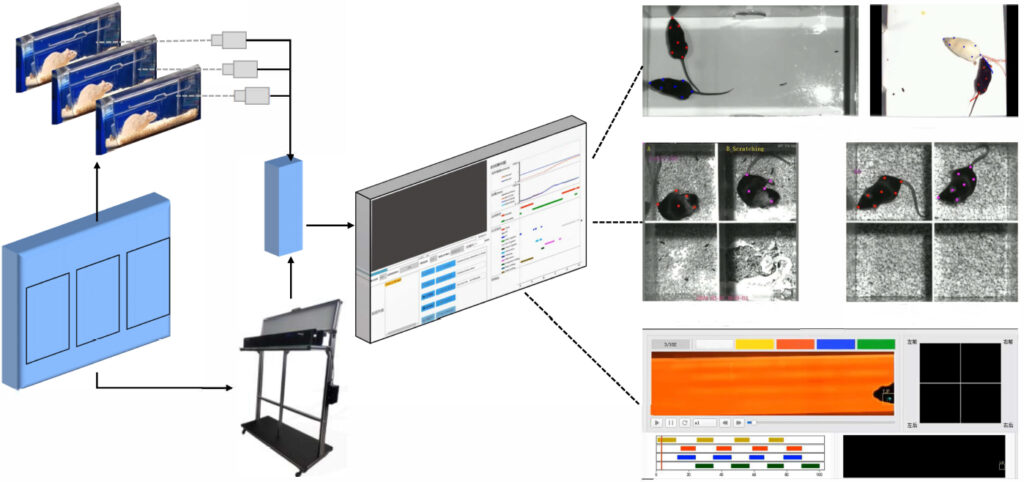The motor functions of mice are a key indicator in many neurobiological studies, particularly in the context of diseases like Parkinson’s and Alzheimer’s. Understanding these functions requires precise measurement and analysis of the walking gait and movements of these animals.
$4,950.00
The motor functions of mice are a key indicator in many neurobiological studies, particularly in the context of diseases like Parkinson’s and Alzheimer’s. Understanding these functions requires precise measurement and analysis of the walking gait and movements of these animals.
Traditional methods for analyzing mouse gait involve manual observation and video recording, which are time-consuming and prone to human error. Moreover, these methods often require the physical handling of the mice, which can cause stress and affect their natural behaviors. There is a clear need for an automated, accurate, and non-invasive method to monitor these animals, which led to the development of the AI-driven behavioral and motor analysis system described in this document.
The system utilizes a combination of high-definition video cameras and AI algorithms to automatically detect and analyze the gait patterns of mice. By employing machine learning techniques, the system can continuously learn and improve its accuracy and efficiency in real-time data processing. This not only enhances the reliability of the data but also reduces the labor and time required for analysis.
The AI-driven behavioral and motor analysis system consists of several key components that work together to capture and analyze the gait of mice accurately. This chapter details these components and their functionalities.
High-definition video cameras are strategically positioned to capture a 360-degree view of the testing arena. These cameras record the movements of the mice in ultra-high resolution, enabling the system to detect minute variations in gait and other motor functions.
The floor of the testing arena is equipped with sensors that detect pressure and movement. This sensory floor helps in determining the force and speed of each step the mouse takes, providing valuable data for analyzing walking stability and stride variations.
At the core of the system is a high-performance data processing unit. This unit is responsible for collecting data from the cameras and sensory floor, processing it through AI algorithms, and outputting the analyzed results. The processing unit uses advanced machine learning models that have been trained to recognize various gait patterns and identify potential abnormalities.
The system is equipped with a user-friendly software interface that allows researchers to view real-time data and results. The interface provides tools for setting parameters, visualizing data in various formats, and generating detailed reports. This enables researchers to make informed decisions quickly during their studies.
The implementation of the AI-driven behavioral and motor analysis system involves a set process that ensures the capture and analysis of high-quality data. This chapter describes the implementation process and the analytical capabilities of the system.
Before initiating a study, the system must be calibrated to ensure accurate data capture. Calibration involves adjusting the cameras and sensors to match the specific dimensions and conditions of the testing arena. Researchers must also input initial parameters related to the specific characteristics of the mice being studied, such as weight and expected movement patterns.
Once the system is calibrated, data capture begins. The system operates continuously, recording every movement of the mice within the arena. The high-definition cameras and sensory floor work in tandem to provide a comprehensive dataset that includes visual and kinetic data of the mice’s movements.
The core of the system’s functionality lies in its ability to analyze the captured data with high accuracy. The data processing unit applies pre-trained AI models to identify and categorize various gait patterns. These models can detect abnormalities in the gait that may indicate neurological or physical ailments. The system provides quantitative assessments of gait stability, stride length, and other crucial parameters.
After analysis, the system generates detailed reports that summarize the findings. These reports include graphical representations of the gait patterns, highlighting any abnormalities detected. Researchers can use these reports to track the progression of conditions over time or to assess the effectiveness of treatments. Additionally, the system offers feedback mechanisms that suggest adjustments to study parameters or additional areas of focus based on preliminary results.
The system is extensively used in neurobiological research to study diseases such as Parkinson’s, Alzheimer’s, and multiple sclerosis. By providing detailed, quantitative data on mouse gait and behavior, it aids researchers in understanding the progression of these diseases and the efficacy of new treatments. Additionally, the system is used in orthopedic research to assess recovery from physical injuries and the effectiveness of rehabilitation techniques.
Ongoing developments in machine learning are enhancing the system’s capabilities. Future updates are expected to introduce more sophisticated AI models that can predict disease progression and treatment outcomes with greater accuracy. These advancements will allow for earlier diagnosis and more personalized treatment plans.
While currently optimized for mice, there is potential to adapt the system for use with other animal models such as rats, rabbits, and even larger animals. This expansion would require modifications to the system’s hardware and software to accommodate different sizes and behaviors, but it would significantly broaden the scope and utility of the research tool.
The future of the system includes integration with other biometric monitoring technologies, such as heart rate and body temperature sensors. Combining these data sources would provide a more holistic view of animal health and behavior, leading to more comprehensive insights and more effective interventions.

There are no questions yet. Be the first to ask a question about this product.
Monday – Friday
9 AM – 5 PM EST
DISCLAIMER: ConductScience and affiliate products are NOT designed for human consumption, testing, or clinical utilization. They are designed for pre-clinical utilization only. Customers purchasing apparatus for the purposes of scientific research or veterinary care affirm adherence to applicable regulatory bodies for the country in which their research or care is conducted.